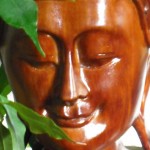
David Morgan, Professor of Religion at Duke University, has written extensively on the subject of material and visual culture. In a recent interview with Christopher Cotter, he provides an overview of the field of material religion and introduces his new book The Embodied Eye: Religious Visual Culture and the Social Life of Feeling (2012). In this review, I briefly tease out some of the themes from the interview, present a few snippets from some of Morgan’s publications and finally, question whether virtual objects can be viewed in a similar manner to physical objects.
The interview commences with Morgan stating that early studies of religion often focused on purely the study of belief and philosophy rather than everyday occurrences. The field of material religion, however, provides a shift in this approach and includes the examination of “everyday life, popular media, things that people practice with, clothing, spaces, pictures” and the media in which “allows for religion to happen as a sensory phenomenon”. The examination of these areas enables an understanding of the importance of objects and the relationship that people have with them. This area of study is found in many of Morgan’s publications, including his new book, The Embodied Eye: Religious Visual Culture and the Social Life of Feeling (2012).
Embodiment, Seeing, Experiencing and Believing
Morgan states that the aim of his new book is to respond to a critique of visual culture studies over recent years. He highlights how religion happens visually, maintaining “that seeing is not disembodied or immaterial and that vision should not be isolated from other forms of sensation and the social life of feeling” (2012: xvii). He explains that the origins of the study of visual culture focused primarily on the object and not the history, ethnography and biography of the object. Thus, he highlights how the perception and usage of the object may change depending on the social context. In The Embodied Eye he provides a number of case studies and examines areas such as, the relationship between embodiment and vision; what is means to see; objects; feelings; and in the concluding chapter questions whether “mental or visionary phenomena belong to visual culture?” (2012: 185). Morgan unpacks this question by querying what it might mean to see the unseen and ultimately, exploring the relationship between images (visible and invisible) and culture.
In other publications, such as “Visual Religion”, attention is given to the importance of how the object is viewed. This can help us to review the relationship between objects and religion, as “Visual practices help fabricate the worlds in which people live and therefore present a promising way of deepening our understanding of how religion works” (2000: 51). This raises our awareness of the importance of the relationship between the object, seeing and experience and so it could be argued that “seeing is part of the embodied experience of feeling, and therefore is properly understood as a fundamental part of many religious practices” (2009: 133). Objects help to construct the world that we live in and become tools to help us make sense of the world around us. Therefore, it is more than just the object, it is about seeing the object, engaging with it and experiencing. Pattison provides an explanation for the triad of object, eye and cognition by stating that “it is not the eye that sees, though sight would be impossible without it. It is the eye-brain working together in an integrated system that creates visual perceptions. These complex perceptual representations constitute our knowledge and experience of reality” (2007: 48).
During the interview Morgan discusses a potential connection between commodification and capitalism. He provides an example of an image which depicts Santa Claus praying before a cross, thus highlighting the intersection between popular culture and religion. For some, this type of image depicts the loss of religion to commercialism and problematizes the relationship between the sacred and the profane. Morgan’s work is not only fascinating but invaluable for understanding the importance of visual and material culture in the study of religion and religion in everyday life.
Virtual Images and Visual Culture
I would like to briefly continue the above discussion and shift the emphasis to focus on objects and virtual reality. This raises a number of questions, including whether or not we can consider virtual objects in the same way as the visible and invisible objects of the physical world and what implications, if any, this has for not only the study of religion but religion itself. There is not space to explore this in depth. However, it is important to initiate such discussions due to the many parallels which could be drawn between the objects used in ritual and communities found in the physical world and those found in the virtual world.
If we take the example of the Buddhist prayer wheel, traditionally this is spun by hand, releasing the prayer and therefore, obtaining merit for the person. The gaining of merit is intrinsic to the Buddhist concept of salvation. However, online, the physical act of touching a prayer wheel is not possible. This leads us to question whether virtual objects can have the same purpose and consequently the desired soteriological outcome. Moreover, what does it mean to “touch” the virtual object?
In some situations, such as those found in the online world of Second Life, creators of the virtual Buddhist prayer wheels design them to replicate those found offline. Often, the virtual prayer wheels are designed with the intention that an avatar must “touch” and spin them. Based on interviews, one creator of virtual Buddhist prayer wheels maintains that there can be the same meritorious results as long as it is spun with the same intention (Connelly, 2010: 18). In this example, the virtual object, at least for some, can have the same purpose to those found offline.
Examining new media and the common themes of authority, community, identity and ritual can prove complex and challenging. The study of religion on the internet includes scholars from a number of fields, such as sociology, psychology, anthropology and more. “This focus and interdisciplinary approach is reflected in a growing scholarly discussion” (Campbell and Connelly 2012: 435). Accordingly, this enables us to widen our understanding of how people are engaging with religion and objects within everyday life – both in the physical and virtual spaces.
This material is disseminated under a Creative Commons Attribution-NonCommercial-NoDerivs 3.0 Unported License. and can be distributed and utilised freely, provided full citation is given.
Bibliography
- Campbell, H. and Connelly, L. (2012). “Cyber Behavior and Religious Practice on the Internet”, in Z. Yan (ed.) Encyclopedia of Cyber Behavior. IGI Global.
- Connelly, L. (2010). “Virtual Buddhism: An Analysis of Aesthetics in Relation to Religious Practice within Second Life”. 4.1 ed., Heidelberg Journal of Religions on the Internet
- Morgan, D. (2000). “Visual Religion”, Religion 30, 41-53.
- . (2009). “The Look of Sympathy: Religion, Visual Culture, and the Social Life of Feeling”, Material Religion 5, 132-155.
- . (2012). The Embodied Eye: Religious Visual Culture and the Social Life of Feeling. University of California Press: California: London
- Pattison, Stephen. (2007). Seeing things: deepening relations with visual artefacts. London: SCM Press.
Additional Resources
Co-founder and co-editor of the international scholarly journal, Material Religion: The Journal of Objects, Art, and Belief, published by Berg Publishers, Oxfordhttp://www.bergpublishers.com/?TabId=517
David Morgan, Duke University, http://www.duke.edu/~dm127/Site/Intro.html



